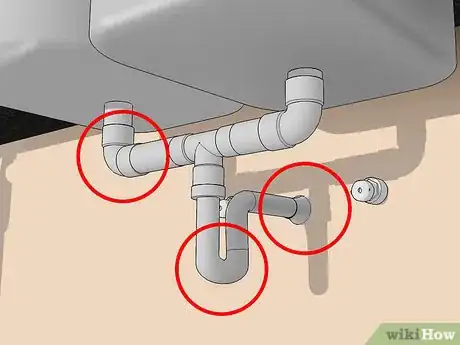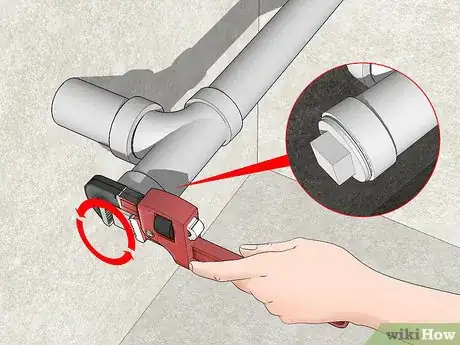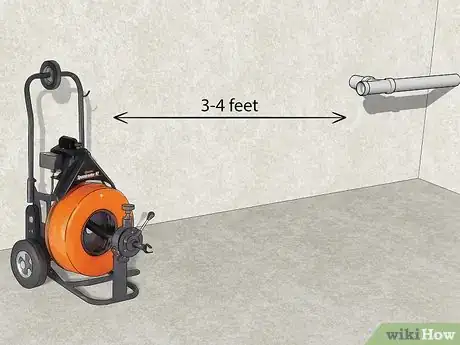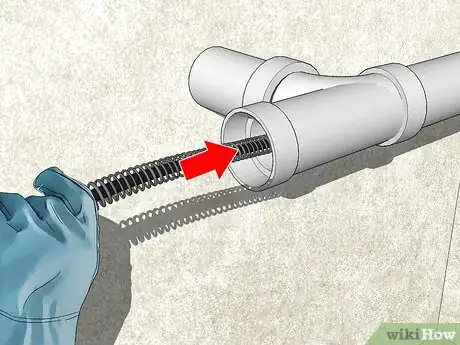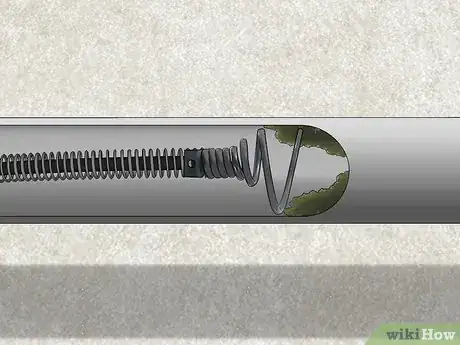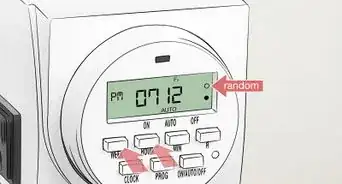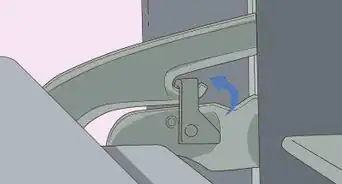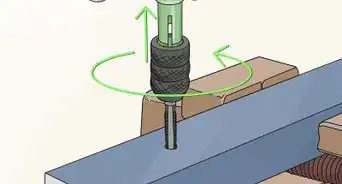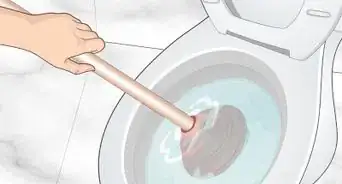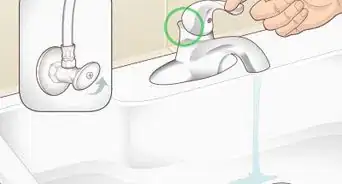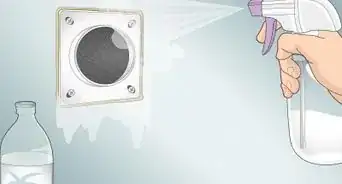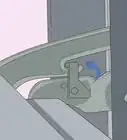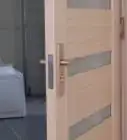This article was co-authored by David Balkan. David Balkan is a Professional Plumber, CEO of Balkan Sewer and Water Main Service, and President of Balkan Sewer and Drain Cleaning. As a hands-on owner of these companies for over 40 years, David is knowledgeable about water service lines, sewers, and drain line issues. David is a Committee Chairman of the Master Plumbers Council and has sat on the Executive Committee of the Sub Surface Plumbers Association of New York for over 30 years. His knowledge and solution-oriented approach contributed to Balkan Sewer and Water Main Service being the largest and most trusted service in New York City and the recipient of the 2017 Angie’s List Super Service Award.
There are 10 references cited in this article, which can be found at the bottom of the page.
This article has been viewed 51,736 times.
A clog in your kitchen or bathroom sink can often be remedied with some simple DIY solutions like a homemade snake or a combination of vinegar and baking soda.[1] But when the blockage is rooted in your main drainage piping, the problem is a bit more complicated. Luckily, with a drain-cleaning machine rental and some safety precautions, you can unclog the pipes that run underneath your home and return your fixtures to normal operation.
Steps
Using Quick DIY Fixes
-
1Snake the piping with a bent hanger for close-by clogs. If the clog isn't too far down the pipe, a hanger might work! Find a wire coat hanger, straighten it out, and bend the tip to a 90-degree angle using a pair of pliers. The length of the hook should be small enough to fit through the drain. Push the hooked end down the drain and into the piping as far as you can. Afterward, twist it and pull it upward.[2]
- Repeat the above process until you pull something out.
- If your drain has a basket strainer—the screen designed to catch foreign particles—remove it from below the sink with an adjustable wrench.
- For a more effective solution, rent or purchase a plumbing snake that you can feed into the drain to clear out any clogs.[3]
-
2Dump a baking soda, salt, and hot water mixture into the piping. Mix 1⁄2 cup (120 mL) of baking soda with 1⁄2 cup (120 mL) of table salt. Stir the mixture with a spoon to ensure a consistent solution. Gently pour the mixture down the drain and let it sit in the piping for 10 to 20 minutes.[4]
- Flush the drain with hot water and see if the drain clears.
Advertisement -
3Flush the piping with a mixture of vinegar and baking soda. Start by pouring a pot of boiling water down the drain. Afterward, mix 1 cup (240 mL) of vinegar with 1 cup (240 mL) of boiling water. Throw 1⁄2 cup (120 mL) of baking soda into the drain and wash it down with your solution. Let the mixture bubble and sit for about 1 hour.[5]
- Run hot water into the piping for 30 seconds after letting the mixture sit.
-
4Suck the clog from the piping using a wet/dry vacuum.[6] If you have a wet/dry vacuum, turn it to the wet setting and use the highest suction possible. Hold it over the drain to the clogged piping and wait for something to come up. Be sure to cover the vacuum vent using a plastic bag or container to catch any particles that make it through the filer.[7]
- Don't try this method with a machine that isn't designed for wet work!
- If nothing comes out, try pressing the nozzle of the vacuum into the drain as far as possible.[8]
Using a Drain-Cleaning Machine
-
1Locate the clogged piping through trial and error. If one fixture is clogged and the trap is not clogged, the drain line from that fixture is likely the culprit. For example, if your sink is not working but the trap is cleared, the drain downstream from the sink is probably clogged. If there are multiple clogs, the clogged pipe is likely downstream from where they connected.[9]
- Upper floor fixtures possess pipes that run under your home's flooring or downward to the basement. Look for floor drains to get a feel for where each pipe runs.
-
2Rent a drain-cleaning machine with a cable at least the length of the pipe. Either locate or estimate the location of the clog and measure the length from the clog to the cleanout plug. Head to a rental store and select a cable length long enough (ideally longer) to reach your clog.
- For small drain lines that are 1.5 to 3 inches (3.8 to 7.6 cm) in diameter, select a cable 1⁄2 inch (1.3 cm) in diameter. For larger piping, select a cable 3⁄4 inch (1.9 cm) in diameter.
-
3Remove the cleanout plug with an adjustable wrench. Cleanout plugs are used to clean out your piping and are located in plumbing fixtures, leading away from your home, or in basement or garage floor drains. Regardless of where it is, have a bucket ready for the water that may drain out. Turn the square notch counterclockwise with your adjustable wrench. If you're having trouble, place a cold chisel to the corner of the square. Now, hit the handle with a hammer to get it going.[10]
- Never remove a cleanout plug or attempt to unclog a pipe that contains chemical drain cleaner.
- Apply penetrating oil to the cleanout plug to loosen it up.
- Wear leather gloves and safety glasses.
-
4Setup the machine 3 to 4 feet (0.91 to 1.22 m) from the cleanout opening. Connect the machine to either a grounded outlet or a 12- to 14-gauge grounded extension cord. Always keep the motor switch in the "Forward" position prior to turning it on. Be sure you aren't wearing loose clothing, jewelry, or belts, and put on safety glasses and heavy duty leather gloves.[11]
- Place the foot-operated switch somewhere easily accessible so you can step on it while feeding the cable into the drain.
- Practice using the machine with the foot switch before trying to unclog the pipe.
- Always follow the instructions given with the equipment—these are powerful machines.
- Never wear cloth or rubber gloves—they can become caught between the coils of the drain-cleaning machine's cable.
-
5Feed the cable into the pipe slowly to locate the clog. Start by feeding the cable with the machine off until it doesn't go any further. Firmly hold the cable with both hands and start the machine's motor with the foot switch. Feed the cable into the pipe slowly while turning the motor on and off. Listen for the slowing of the motor and feel for an increase in the tension of the cable. Once you sense either change, stop immediately by taking your foot off the motor.[12]
- Never allow tension to build in your cable, which often happens when the cutting head hits an obstacle and stops turning.
-
6Turn the motor to "Reverse" to relieve tension from the cable. After switching to "Reverse," hit the foot switch and watch the cable cage for 3 to 4 revolutions. This will decrease tension that accumulated in the cable after contacting the clog. Now, switch the motor to "Forward" again to continue chewing through the clog.[13]
- Proceed slowly and carefully to avoid the cable suddenly twisting around your arm.
- Only use the "Reverse" motor option when the cable will not go forward or to relieve tension when removing the clog.
-
7Chew through the clog slowly and carefully. After you reach the clog, tighten the lock bolt located above the region the cable leaves the machine. While holding the cable and making sure the machine is running on "Forward," hit the foot switch. After it is depressed, loosen the lock bolt and wait for another 2 to 3 rotations of the cable. Now, retighten the lock bolt.
- Continue this process until the clog is removed.
Expert Q&A
-
QuestionHow do you unclog a shower drain by yourself?
 James SchuelkeJames Schuelke, along with his twin brother David, is the co-owner of the Twin Home Experts, a licensed plumbing, leak detection, and mold inspection company based in Los Angeles, California. James has over 32 years of home service and business plumbing experience and has expanded the Twin Home Experts to Phoenix, Arizona and the Pacific Northwest.
James SchuelkeJames Schuelke, along with his twin brother David, is the co-owner of the Twin Home Experts, a licensed plumbing, leak detection, and mold inspection company based in Los Angeles, California. James has over 32 years of home service and business plumbing experience and has expanded the Twin Home Experts to Phoenix, Arizona and the Pacific Northwest.
Professional Plumber I recommend using a wet/dry vacuum, as it can extract organic matter like hair and soap scum. Take the drain cover off the shower, put the vacuum hose right up against the drain, and turn it on. That should extract anything clogging the drain.
I recommend using a wet/dry vacuum, as it can extract organic matter like hair and soap scum. Take the drain cover off the shower, put the vacuum hose right up against the drain, and turn it on. That should extract anything clogging the drain. -
QuestionCan a wet/dry vac unclog a drain?
 James SchuelkeJames Schuelke, along with his twin brother David, is the co-owner of the Twin Home Experts, a licensed plumbing, leak detection, and mold inspection company based in Los Angeles, California. James has over 32 years of home service and business plumbing experience and has expanded the Twin Home Experts to Phoenix, Arizona and the Pacific Northwest.
James SchuelkeJames Schuelke, along with his twin brother David, is the co-owner of the Twin Home Experts, a licensed plumbing, leak detection, and mold inspection company based in Los Angeles, California. James has over 32 years of home service and business plumbing experience and has expanded the Twin Home Experts to Phoenix, Arizona and the Pacific Northwest.
Professional Plumber Yes, you can use your wet/dry vac to unclog a drain. Hold the opening of the nozzle over the drain to suck out the clog. If nothing comes up, push the nozzle as far into the drain as it will go. Hopefully, this will dislodge the clog.
Yes, you can use your wet/dry vac to unclog a drain. Hold the opening of the nozzle over the drain to suck out the clog. If nothing comes up, push the nozzle as far into the drain as it will go. Hopefully, this will dislodge the clog. -
QuestionWhat is the best home remedy for clogged drains?
 James SchuelkeJames Schuelke, along with his twin brother David, is the co-owner of the Twin Home Experts, a licensed plumbing, leak detection, and mold inspection company based in Los Angeles, California. James has over 32 years of home service and business plumbing experience and has expanded the Twin Home Experts to Phoenix, Arizona and the Pacific Northwest.
James SchuelkeJames Schuelke, along with his twin brother David, is the co-owner of the Twin Home Experts, a licensed plumbing, leak detection, and mold inspection company based in Los Angeles, California. James has over 32 years of home service and business plumbing experience and has expanded the Twin Home Experts to Phoenix, Arizona and the Pacific Northwest.
Professional Plumber Sucking out the clog with a wet/dry vac is a great option, but you can also use a homemade snake. If you prefer pouring a solution down your drain, try a vinegar-baking soda mixture. Pour the mixture down the drain to help flush the clog.
Sucking out the clog with a wet/dry vac is a great option, but you can also use a homemade snake. If you prefer pouring a solution down your drain, try a vinegar-baking soda mixture. Pour the mixture down the drain to help flush the clog.
Things You'll Need
- Drain-cleaning machine
- Alan wrench
- Cold chisel
- Hammer
- Pipe wrench
- Rags
- Safety glasses
References
- ↑ James Schuelke. Professional Plumber. Expert Interview. 1 October 2019.
- ↑ https://www.familyhandyman.com/plumbing/drain-repair/unclog-a-kitchen-sink/view-all/
- ↑ David Balkan. Professional Plumber & CEO of Balkan Sewer & Water Main. Expert Interview. 23 February 2021.
- ↑ https://www.mom4real.com/unclog-drains-baking-soda-vinegar-natural-cleaning-trick/
- ↑ https://www.mom4real.com/unclog-drains-baking-soda-vinegar-natural-cleaning-trick/
- ↑ James Schuelke. Professional Plumber. Expert Interview. 1 October 2019.
- ↑ https://housewifehowtos.com/clean/how-to-unclog-drains/
- ↑ James Schuelke. Professional Plumber. Expert Interview. 1 October 2019.
- ↑ https://www.familyhandyman.com/plumbing/drain-repair/how-to-unclog-a-drain-that-s-hopelessly-clogged/view-all/
- ↑ https://www.lowes.com/projects/repair-and-maintain/unclog-main-drain-line/project
- ↑ https://www.plumbermag.com/how-to-articles/detection_leak_safety_cleaners/15_drain_cleaning_machine_safety_tips_to_keep_you_alive_sc_01ck7
- ↑ https://youtu.be/9YNZIG5SDNQ?t=528
- ↑ https://www.familyhandyman.com/plumbing/drain-repair/how-to-unclog-a-drain-that-s-hopelessly-clogged/view-all/






